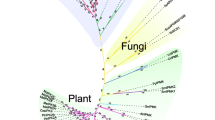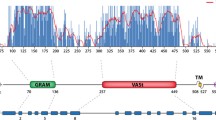Abstract
Dual-specificity phosphatases (DSPs) constitute a large protein tyrosine phosphatase (PTP) family, with examples in distant evolutive phyla. PFA-DSPs (Plant and Fungi Atypical DSPs) are a group of atypical DSPs present in plants, fungi, kinetoplastids, and slime molds, the members of which share structural similarity with atypical- and lipid phosphatase DSPs from mammals. The analysis of the PFA-DSPs from the plant Arabidopsis thaliana (AtPFA-DSPs) showed differential tissue mRNA expression, substrate specificity, and catalytic activity for these proteins, suggesting different functional roles among plant PFA-DSPs. Bioinformatic analysis revealed the existence of novel PFA-DSP-related proteins in fungi (Oca1, Oca2, Oca4 and Oca6 in Saccharomyces cerevisiae) and protozoa, which were segregated from plant PFA-DSPs. The closest yeast homolog for these proteins was the PFA-DSP from S. cerevisiae ScPFA-DSP1/Siw14/Oca3. Oca1, Oca2, Siw14/Oca3, Oca4, and Oca6 were involved in the yeast response to caffeine and rapamycin stresses. Siw14/Oca3 was an active phosphatase in vitro, whereas no phosphatase activity could be detected for Oca1. Remarkably, overexpression of Siw14/Oca3 suppressed the caffeine sensitivity of oca1, oca2, oca4, and oca6 deleted strains, indicating a genetic linkage and suggesting a functional relationship for these proteins. Functional studies on mutations targeting putative catalytic residues from the A. thaliana AtPFA-DSP1/At1g05000 protein indicated the absence of canonical amino acids acting as the general acid/base in the phosphor-ester hydrolysis, which suggests a specific mechanism of reaction for PFA-DSPs and related enzymes. Our studies demonstrate the existence of novel phosphatase protein families in fungi and protozoa, with active and inactive enzymes linked in common signaling pathways. This illustrates the catalytic and functional complexity of the expanding family of atypical dual-specificity phosphatases in non-metazoans, including parasite organisms responsible for infectious human diseases.





Similar content being viewed by others
References
Aceti DJ et al (2008) Structural and functional characterization of a novel phosphatase from the Arabidopsis thaliana gene locus At1g05000. Proteins 73:241–253
Addinall SG et al (2008) A genomewide suppressor and enhancer analysis of cdc13–1 reveals varied cellular processes influencing telomere capping in Saccharomyces cerevisiae. Genetics 180:2251–2266
Alic N, Higgins VJ, Dawes IW (2001) Identification of a Saccharomyces cerevisiae gene that is required for G1 arrest in response to the lipid oxidation product linoleic acid hydroperoxide*. Mol Biol Cell 12:1801–1810
Alonso A, Rojas A, Godzik A, Mustelin T (2004a) The dual-specific protein tyrosine phosphatase family. In: Ariño J, Alexander DR (eds) Topics in current genetics: protein phosphatases. Springer, Berlin, pp 333–358
Alonso A, Sasin J, Bottini N, Friedberg I, Friedberg I, Osterman A, Godzik A, Hunter T, Dixon J, Mustelin T et al (2004b) Protein tyrosine phosphatases in the human genome. Cell 117:699–711
Andreeva AV, Kutuzov MA (2008) Protozoan protein tyrosine phosphatases. Int J Parasitol 38:1279–1295
Attwood TK, Findlay JB (1993) Design of a discriminating fingerprint for G-protein-coupled receptors. Protein Eng 6:167–176
Attwood TK, Findlay JB (1994) Fingerprinting G-protein-coupled receptors. Protein Eng 7:195–203
Baker NA, Sept D, Joseph S, Holst MJ, McCammon JA (2001) Electrostatics of nanosystems: application to microtubules and the ribosome. Proc Natl Acad Sci USA 98:10037–10041
Bartels S et al (2009) MAP kinase phosphatase1 and protein tyrosine phosphatase1 are repressors of salicylic acid synthesis and SNC1-mediated responses in Arabidopsis. Plant Cell 21:2884–2897
Begley MJ, Dixon JE (2005) The structure and regulation of myotubularin phosphatases. Curr Opin Struct Biol 15:614–620
Beresford N, Patel S, Armstrong J, Szoor B, Fordham-Skelton AP, Tabernero L (2007) MptpB, a virulence factor from Mycobacterium tuberculosis, exhibits triple-specificity phosphatase activity. Biochem J 406:13–18
Beresford NJ, Saville C, Bennett HJ, Roberts IS, Tabernero L (2010) A new family of phosphoinositide phosphatases in microorganisms: identification and biochemical analysis. BMC Genomics 11:457
Brenchley R et al (2007) The TriTryp phosphatome: analysis of the protein phosphatase catalytic domains. BMC Genomics 8:434
Care A et al (2004) A synthetic lethal screen identifies a role for the cortical actin patch/endocytosis complex in the response to nutrient deprivation in Saccharomyces cerevisiae. Genetics 166:707–719
Chen W, Wilborn M, Rudolph J (2000) Dual-specific Cdc25B phosphatase: in search of the catalytic acid. Biochemistry 39:10781–10789
Collins SR et al (2007) Toward a comprehensive atlas of the physical interactome of Saccharomyces cerevisiae. Mol Cell Proteomics 6:439–450
Denu JM, Zhou G, Guo Y, Dixon JE (1995) The catalytic role of aspartic acid-92 in a human dual-specific protein-tyrosine-phosphatase. Biochemistry 34:3396–3403
Doi K et al (1994) MSG5, a novel protein phosphatase promotes adaptation to pheromone response in S. cerevisiae. EMBO J 13:61–70
Dudley AM, Janse DM, Tanay A, Shamir R, Church GM (2005) A global view of pleiotropy and phenotypically derived gene function in yeast. Mol Syst Biol 1:2005 0001
Felsentein J (1989) PHYLIP—phylogeny inference package (Version 3.2). Cladistics 5:164–166
Flandez M, Cosano IC, Nombela C, Martin H, Molina M (2004) Reciprocal regulation between Slt2 MAPK and isoforms of Msg5 dual-specificity protein phosphatase modulates the yeast cell integrity pathway. J Biol Chem 279:11027–11034
Fox GC et al (2007) Redox-mediated substrate recognition by Sdp1 defines a new group of tyrosine phosphatases. Nature 447:487–492
Gingras MC et al (2009) HD-PTP is a catalytically inactive tyrosine phosphatase due to a conserved divergence in its phosphatase domain. PLoS One 4:e5105
Gonzalez A, Ruiz A, Casamayor A, Arino J (2009) Normal function of the yeast TOR pathway requires the type 2C protein phosphatase Ptc1. Mol Cell Biol 29:2876–2888
Gross S et al (2002) Multimerization of the protein-tyrosine phosphatase (PTP)-like insulin-dependent diabetes mellitus autoantigens IA-2 and IA-2beta with receptor PTPs (RPTPs) inhibition of RPTPalpha enzymatic activity. J Biol Chem 277:48139–48145
Guindon S, Gascuel O (2003) A simple, fast, and accurate algorithm to estimate large phylogenies by maximum likelihood. Syst Biol 52:696–704
Hahn JS, Thiele DJ (2002) Regulation of the Saccharomyces cerevisiae Slt2 kinase pathway by the stress-inducible Sdp1 dual specificity phosphatase. J Biol Chem 277:21278–21284
Hampsey M (1997) A review of phenotypes in Saccharomyces cerevisiae. Yeast 13:1099–1133
Hinton SD, Myers MP, Roggero VR, Allison LA, Tonks NK (2010) The pseudophosphatase MK-STYX interacts with G3BP and decreases stress granule formation. Biochem J 427:349–357
Hirasaki M, Kaneko Y, Harashima S (2008) Protein phosphatase Siw14 controls intracellular localization of Gln3 in cooperation with Npr1 kinase in Saccharomyces cerevisiae. Gene 409:34–43
Hirasaki M et al (2010) Deciphering cellular functions of protein phosphatases by comparison of gene expression profiles in Saccharomyces cerevisiae. J Biosci Bioeng 109:433–441
Ito T, Chiba T, Ozawa R, Yoshida M, Hattori M, Sakaki Y (2001) A comprehensive two-hybrid analysis to explore the yeast protein interactome. Proc Natl Acad Sci USA 98:4569–4574
Kennelly PJ (2001) Protein phosphatases—a phylogenetic perspective. Chem Rev 101:2291–2312
Kuranda K, Leberre V, Sokol S, Palamarczyk G, Francois J (2006) Investigating the caffeine effects in the yeast Saccharomyces cerevisiae brings new insights into the connection between TOR, PKC and Ras/cAMP signalling pathways. Mol Microbiol 61:1147–1166
Lambert C, Leonard N, De Bolle X, Depiereux E (2002) ESyPred3D: prediction of proteins 3D structures. Bioinformatics 18:1250–1256
Lee JO et al (1999) Crystal structure of the PTEN tumor suppressor: implications for its phosphoinositide phosphatase activity and membrane association. Cell 99:323–334
Luan S (2003) Protein phosphatases in plants. Annu Rev Plant Biol 54:63–92
Maehama T, Taylor GS, Dixon JE (2001) PTEN and myotubularin: novel phosphoinositide phosphatases. Annu Rev Biochem 70:247–279
Martin H, Flandez M, Nombela C, Molina M (2005) Protein phosphatases in MAPK signalling: we keep learning from yeast. Mol Microbiol 58:6–16
Moorhead GB, De Wever V, Templeton G, Kerk D (2009) Evolution of protein phosphatases in plants and animals. Biochem J 417:401–409
Nordle AK, Rios P, Gaulton A, Pulido R, Attwood TK, Tabernero L (2007) Functional assignment of MAPK phosphatase domains. Proteins 69:19–31
Owens DM, Keyse SM (2007) Differential regulation of MAP kinase signalling by dual-specificity protein phosphatases. Oncogene 26:3203–3213
Page RD (1996) TreeView: an application to display phylogenetic trees on personal computers. Comput Appl Biosci 12:357–358
Parsons AB et al (2004) Integration of chemical-genetic and genetic interaction data links bioactive compounds to cellular target pathways. Nat Biotechnol 22:62–69
Pfaffl MW (2001) A new mathematical model for relative quantification in real-time RT-PCR. Nucleic Acids Res 29:e45
Pincus D, Letunic I, Bork P, Lim WA (2008) Evolution of the phospho-tyrosine signaling machinery in premetazoan lineages. Proc Natl Acad Sci USA 105:9680–9684
Reinke A, Chen JC, Aronova S, Powers T (2006) Caffeine targets TOR complex I and provides evidence for a regulatory link between the FRB and kinase domains of Tor1p. J Biol Chem 281:31616–31626
Rieger KJ, El-Alama M, Stein G, Bradshaw C, Slonimski PP, Maundrell K (1999) Chemotyping of yeast mutants using robotics. Yeast 15:973–986
Romá-Mateo C, Ríos P, Tabernero L, Attwood TK, Pulido R (2007) A novel phosphatase family, structurally related to dual-specificity phosphatases, that displays unique amino acid sequence and substrate specificity. J Mol Biol 374:899–909
Sakumoto N, Matsuoka I, Mukai Y, Ogawa N, Kaneko Y, Harashima S (2002) A series of double disruptants for protein phosphatase genes in Saccharomyces cerevisiae and their phenotypic analysis. Yeast 19:587–599
Torii S (2009) Expression and function of IA-2 family proteins, unique neuroendocrine-specific protein-tyrosine phosphatases. Endocr J 56:639–648
Ulm R, Revenkova E, di Sansebastiano GP, Bechtold N, Paszkowski J (2001) Mitogen-activated protein kinase phosphatase is required for genotoxic stress relief in Arabidopsis. Genes Dev 15:699–709
Ulm R et al (2002) Distinct regulation of salinity and genotoxic stress responses by Arabidopsis MAP kinase phosphatase 1. EMBO J 21:6483–6493
Wilkes JM, Doerig C (2008) The protein-phosphatome of the human malaria parasite Plasmodium falciparum. BMC Genomics 9:412
Winter G, Hazan R, Bakalinsky AT, Abeliovich H (2008) Caffeine induces macroautophagy and confers a cytocidal effect on food spoilage yeast in combination with benzoic acid. Autophagy 4:28–36
Wishart MJ, Dixon JE (1998) Gathering STYX: phosphatase-like form predicts functions for unique protein-interaction domains. Trends Biochem Sci 23:301–306
Xie MW et al (2005) Insights into TOR function and rapamycin response: chemical genomic profiling by using a high-density cell array method. Proc Natl Acad Sci USA 102:7215–7220
Yuvaniyama J, Denu JM, Dixon JE, Saper MA (1996) Crystal structure of the dual specificity protein phosphatase VHR. Science 272:1328–1331
Zhou H, Luo Y, Huang S (2010) Updates of mTOR inhibitors. Anticancer Agents Med Chem 10:571–581
Zimmermann P, Hirsch-Hoffmann M, Hennig L, Gruissem W (2004) GENEVESTIGATOR. Arabidopsis microarray database and analysis toolbox. Plant Physiol 136:2621–2632
Acknowledgments
This work was supported in part by grants SAF2006-08319 from Ministerio de Educación y Ciencia, SAF2009-10226 from Ministerio de Ciencia e Innovación (Spain and Fondo Europeo de Desarrollo Regional, FEDER; Plan de estímulo a la economía y el empleo, Plan E), AP-117/08, ACOMP2009/363 and ACOMP2010/222 from Generalitat Valenciana (Spain) (to R.P.), G0701233 from Medical Research Council (U.K.) (to L.T.), BIO2007-67299 from Ministerio de Ciencia e Innovación (Spain) (to M.M.), and by European Union Research Training Network MRTN-CT-2006-035830. C. Romá-Mateo and A. Sacristán-Reviriego have been recipients of predoctoral fellowships from Ministerio de Educación y Ciencia (Spain). We thank Peter Sudbery and José Luis Revuelta for providing cDNAs, the Arabidopsis Biological Resource Center (USA; donors: SSP Consortium, Sakis Theologis, Joe Ecker) for providing plasmids, and Isabel Roglá and Charis Saville for expert technical assistance.
Author information
Authors and Affiliations
Corresponding author
Additional information
Communicated by M. Collart.
Electronic supplementary material
Below is the link to the electronic supplementary material.
Rights and permissions
About this article
Cite this article
Romá-Mateo, C., Sacristán-Reviriego, A., Beresford, N.J. et al. Phylogenetic and genetic linkage between novel atypical dual-specificity phosphatases from non-metazoan organisms. Mol Genet Genomics 285, 341–354 (2011). https://doi.org/10.1007/s00438-011-0611-6
Received:
Accepted:
Published:
Issue Date:
DOI: https://doi.org/10.1007/s00438-011-0611-6




